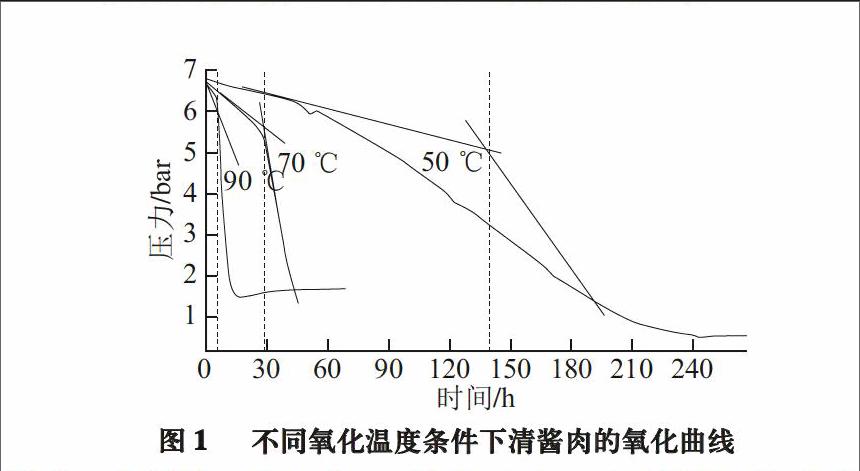北京清酱肉诱导氧化及哈败气味分析
2016-03-12成晓瑜刘文营张顺亮赵冰李
成晓瑜++刘文营++张顺亮++赵冰++李迎楠++贾晓云++王守伟



摘 要:采用脂肪诱导氧化方法对北京清酱肉进行诱导氧化稳定期考察,并借助固相微萃取-嗅闻-气相色谱质谱法对氧化产生哈败味道的样品进行挥发性气味分析。结果表明:诱导温度与诱导期呈负相关性,90 ℃氧化诱导期只有5.26 h。清酱肉经诱导氧化后出现哈败味,经嗅闻-气质色谱共筛选出44 种挥发性气味成分,其中对照组27 种,哈败组31~34 种。哈败后清酱肉的醛类的种类增加最明显,由5 种增加到13 种,其中己醛的相对含量增加最高,3-甲基丁醛、戊醛、反-2-辛烯醛、癸醛、反-2-壬烯醛、反-2-癸烯醛、反,反-2,4-癸二烯醛为新增的醛类物质,它们均对哈败气味的呈现起到一定作用。
关键词:固相微萃取-嗅闻-气相色谱质谱法;北京清酱肉;气味;诱导氧化
Analysis of Induced Oxidation and Main Rancid Compounds of Beijing Pickled Sauced Meat
CHENG Xiaoyu, liu Wenying, ZHANG Shunliang, ZHAO Bing, LI Yingnan, JIA Xiaoyun, WANG Shouwei*
(China Meat Processing and Engineering Center, China Meat Research Center, Beijing Academy of Food Sciences, Beijing 100068, China)
Abstract: The induction of fat oxidation was performed to evaluate the oxidation stability of Beijing pickled sauced meat and the main volatile odor compounds responsible for its oxidative rancidity were analyzed by solid-phase microextraction (SPME) combined with gas chromatography-mass spectrometry-olfactometry (GC-MS-O). The results showed that temperature had a negative correlation with the induction period of fat oxidation; the oxidation period was only 5.26 h at
90 ℃. The meat product developed a rancid odor after induction of fat oxidation. A total of 44 volatile odor compounds were detected by GC-MS-O, 27 compounds of which existed in control samples and 31–34 of which in oxidized samples. The number of aldehydes increased most obviously, from 5 to 13, and 7 new aldehydes, isovaleraldehyde, valeraldehyde, (e)-2-octenal, decanal, E,E-2,4-decedienal, 3-heptylacrolein and trans-2-nonenal, were identified, all of which played a role in the rancid odor. The maximum increase in the relative amount of hexanal was observed among all the identified aldehyde compounds.
Key words: solid-phase microextraction combined with gas chromatography-mass spectrometry-olfactometry (SPME- GC-MS-O); Beijing pickled sauced meat; odor; induced oxidation
DOI:10.15922/j.cnki.rlyj.2016.02.001
中图分类号:TS251.5 文献标志码:A 文章编号:1001-8123(2016)02-0001-04
引文格式:
成晓瑜, 刘文营, 张顺亮, 等. 北京清酱肉诱导氧化及哈败气味分析[J]. 肉类研究, 2016, 30(2): 1-4. DOI:10.15922/j.cnki.rlyj.2016.02.001. http://rlyj.cbpt.cnki.net
CHENG Xiaoyu, LIU Wenying, ZHANG Shunliang, et al. Analysis of induced oxidation and main rancid compounds of Beijing pickled sauced meat[J]. Meat Research, 2016, 30(2): 1-4. (in Chinese with English abstract) DOI:10.15922/j.cnki.rlyj.2016.02.001. http://rlyj.cbpt.cnki.net
北京清酱肉是中国汉族传统名食,创制于明代,至今已有400多年的历史。《天桥杂咏》云:“故都肉味比江南,清酱腌成亦美甘,火腿金华广东腊;堪为鼎足共称三大名肉[1]。”其色泽酱红,清香鲜美,利口不腻,肥肉薄片,晶莹透明,瘦肉片则不柴不散,风味独特。清酱肉主要经过盐腌、酱腌、风干等工艺,前后需要几个月的时间[2]。清酱肉属于我国传统腌腊肉制品,而在腌腊肉制品中脂肪的水解和氧化在其风味体现中发挥着重要的作用[3]。但是脂肪极易氧化,俗称脂肪“哈败”或称“酸败”,而失去了食用价值。油脂的一级氧化产物是氢过氧化物,表明油脂受到氧化的初级程度,是油脂氧化哈败的关键产物[4]。
